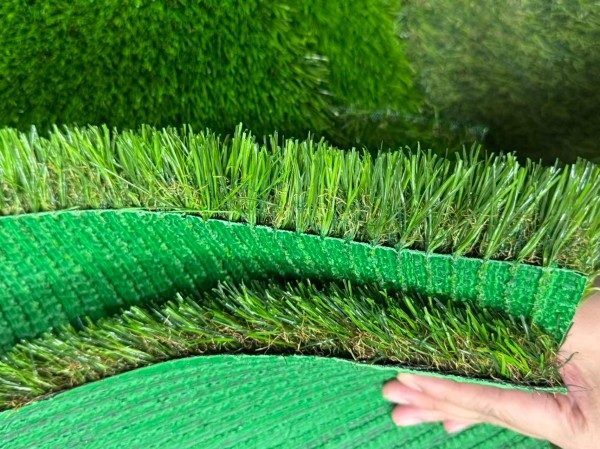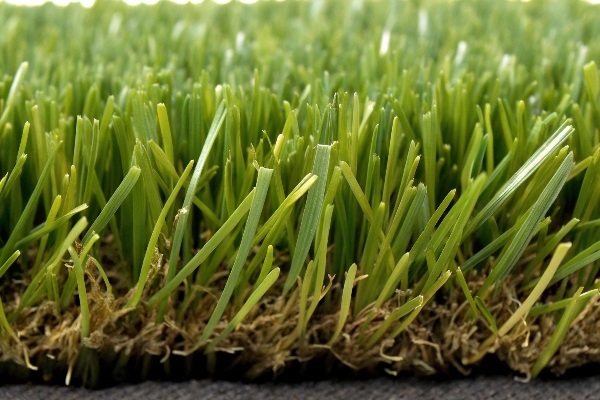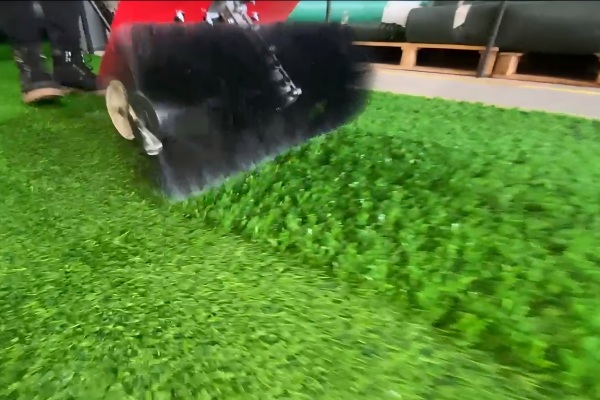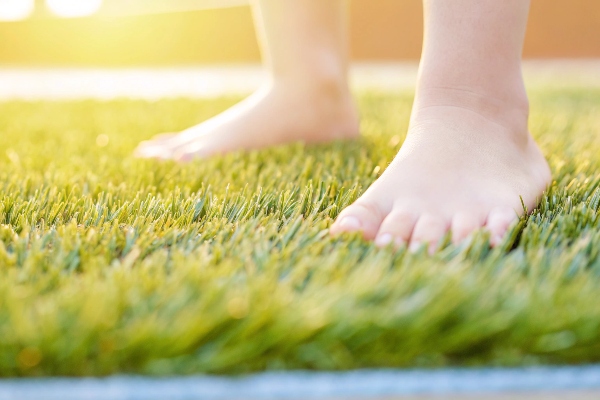Tired of artificial grass that looks obviously fake? This can disappoint clients and cheapen your projects. Discover the key factors that create the most realistic look for your turf.
The most realistic-looking artificial grass combines several factors. It uses multi-toned yarns, has a "thatch" layer of curly brown fibers, features a V, S, or C-shaped blade shape, and has a high pile height and density. The best choice depends on the specific, desired look.

Getting that realistic look is more than just picking a product off the shelf. I’ve spent years in this industry, from the factory floor to leading a sales team, and I’ve seen how tiny details make a huge difference. Every step matters, from the yarn’s design to the final installation. Let’s break down what really makes artificial grass look and feel like the real thing. It’s a journey from understanding the visual aspects to the tactile feel, and I’m here to guide you through it.
What is the most natural looking artificial grass?
Struggling to find artificial grass that doesn’t scream "fake"? The wrong choice can look plastic and unnatural, cheapening your project. Focus on color variation, thatch, and blade shape.
The most natural-looking artificial grass mimics real grass imperfections. It features multiple shades of green mixed with beige or brown "thatch" fibers at the base. A matte finish and non-uniform blade shapes (like ‘S’ or ‘C’) are also key for a natural appearance.

The secret to a natural look is in the details that copy nature. I always tell my clients that perfection looks fake. Real grass is never a single, uniform color. The best artificial turf products understood this long ago.
The Role of Color and Thatch
A truly natural-looking turf uses several colors. Usually, it’s a mix of two or three shades of green. This imitates the new and old blades of a living lawn. But the real game-changer is the "thatch layer". This is a shorter, curly yarn, often beige or brown, that sits at the base of the green blades. It mimics the dead organic matter in a real lawn. In my early days in the workshop, I saw how turf without thatch looked like a green plastic carpet. Adding that thatch layer was a major leap forward for the whole industry. It adds depth and authenticity that you can’t achieve otherwise.
Blade Shape and Sheen
The shape of the individual grass blades is also critical. Early artificial grass used flat blades, which reflected a lot of light. This created an unnatural, plastic-like shine. Modern manufacturing creates more complex shapes to solve this.
| Blade Shape | Realism Factor | Durability |
|---|---|---|
| S-Shape | Excellent (diffuses light well) | High |
| C-Shape | Good (stands up well, less shine) | Very High |
| V-Shape | Good (great for standing upright) | High |
| Flat | Low (very shiny, looks plastic) | Low |
The S-shape and C-shape are my personal favorites for landscaping because they scatter light in many directions. This gives the turf a soft, matte finish that looks much more like real grass under the sun.
How to make artificial grass look more realistic?
Your new artificial grass is installed, but something looks off. A bad installation can ruin a quality product, making it look fake. Proper infill, brushing, and edging are essential.
To make artificial grass look more realistic, use the correct amount of infill like silica sand to help the blades stand up. Brush the grass against the grain with a power broom to make it fluffy. Also, make sure edges are properly secured and hidden for a seamless look.

I’ve learned that a great product is only half the battle. Excellent installation is what brings the realism to life. I have seen beautiful, expensive turf look cheap because of careless installation. On the other hand, a skilled installer can make even a mid-range product look fantastic.
The Importance of Infill
Infill is the granular material, usually silica sand, spread between the grass fibers. It does three crucial jobs. First, it adds weight to hold the turf down and prevent wrinkles. Second, it protects the backing from sun damage. Third, and most importantly for realism, it helps the individual blades stand up straight. Without infill, the grass will look flat and matted. I always advise customers not to skimp on infill. The amount needed depends on the pile height, and using the right amount is a direct investment in the final look of the project.
Brushing and Seaming Techniques
When artificial grass is delivered, it’s in a tightly wound roll. The fibers are compressed and flat. Brushing the turf with a power broom, a process called "blooming," is necessary. This lifts the fibers and makes the lawn look full and natural. Another dead giveaway of fake grass is visible seams where two pieces of turf meet. As a manager, I was extremely strict about this with our installation partners. The edges must be cut perfectly, joined with high-quality seaming tape and adhesive, and the fibers must be blended so the seam becomes invisible. This takes skill and patience, but it’s non-negotiable for a professional result.
Is there turf that feels like grass?
You love the look of artificial turf but worry it feels rough and plastic. A scratchy surface is unpleasant for families with kids and pets, defeating the purpose of a comfortable lawn.
Yes, modern artificial turf can feel remarkably like real grass. Look for products made from Polyethylene (PE) fibers, which are known for their softness. Turf with a good density and a thatch layer will also provide a soft, cushioned feel underfoot.

In the early days of my career, the focus was mostly on durability and appearance. But now, the feel is just as important. Customers want a lawn their kids can play on barefoot. We have spent countless hours in development perfecting that soft, natural feel, and it largely comes down to the materials we use.
The Science of Softness: Fiber Material
The type of plastic used for the yarn makes the biggest difference to the touch. For projects where feel is the top priority, Polyethylene is the only way to go.
| Material | Primary Use | Feel |
|---|---|---|
| Polyethylene (PE) | Landscape, Playgrounds | Softest |
| Polypropylene (PP) | Putting Greens, Trim | Stiffer |
| Nylon | High-Traffic Sports | Most Durable, can be abrasive |
Polyethylene (PE) is the softest and most widely used material for landscape grass. It doesn’t have the abrasive texture that Nylon can have, and it’s much less stiff than Polypropylene. I remember working on a product line specifically for a client who supplied residential projects. His main selling point was a "barefoot-friendly" lawn. We used a premium PE fiber with a high density, and the feedback was incredible.
Density, Pile Height, and Thatch
Besides the material, other specifications contribute to a soft feel. "Face weight" or "density" tells you how many fibers are stitched into each square meter. Higher density means a plusher, more cushioned surface. Pile height, the length of the blades, also helps. A longer blade (35-45mm) feels more luxurious. Finally, the curly thatch layer I mentioned for looks also adds a springy, soft base. It acts like a built-in cushion. A turf with low density, short pile, and no thatch will feel thin and hard, no matter what material it’s made from.
Conclusion
The most realistic artificial grass combines multi-toned colors, ‘S’ or ‘C’ shaped blades, and proper installation. Focusing on these details ensures a look and feel that truly mimics nature.
_画板-1.png)
_画板-1.png)